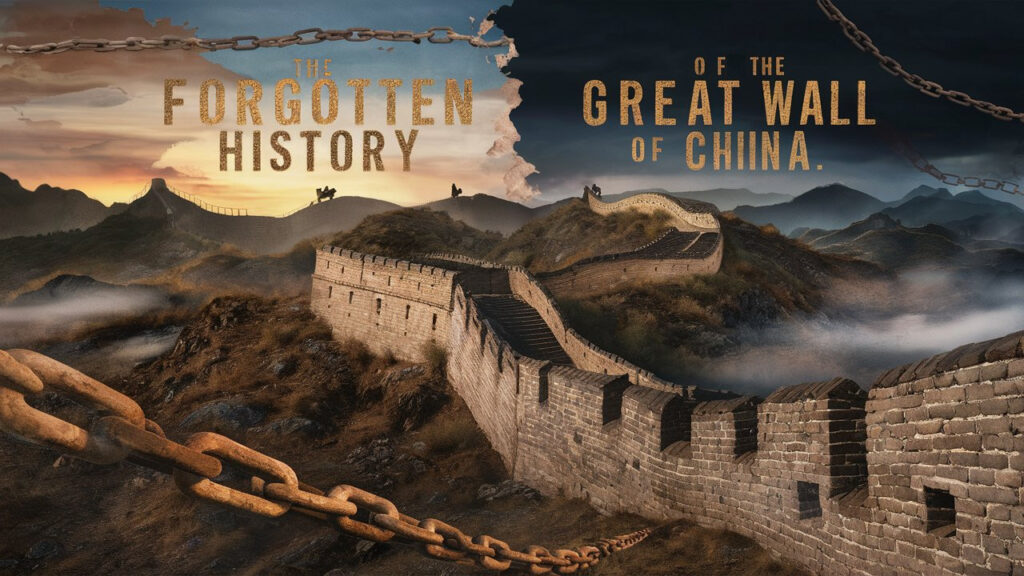The Forgotten History of the Great Wall of China

The Great Wall of China is one of the most iconic structures in the world. Stretching over 13,000 miles, it represents China’s ancient history, military strategy, and endurance. While most people are familiar with its grandeur and its purpose as a defense against invasions, there is a lesser-known story behind the wall’s construction, its evolution, and the people who built it. In this article, we’ll explore the forgotten history of the Great Wall of China and uncover some of the untold stories surrounding this monumental achievement.
The Early Origins: Before the Great Wall
Most people associate the Great Wall with the Qin Dynasty (221-206 BCE), but its origins actually go much further back in history.
The First Walls:
As early as the 7th century BCE, Chinese states built earthworks and rudimentary walls to defend their territories from neighboring tribes. These early fortifications were much smaller and less advanced compared to the later versions of the Great Wall but laid the foundation for what would become one of the most remarkable structures in the world.
The Warring States Period (475-221 BCE):
During the Warring States period, China was divided into several feudal kingdoms that constantly fought each other. Each kingdom constructed its own walls for protection. The most notable of these walls was built by the Qi, Yan, and Zhao states. However, these were regional walls, not the unified Great Wall we know today.
The Qin Dynasty: The First Unified Wall
The story of the Great Wall begins in earnest during the Qin Dynasty under the leadership of Emperor Qin Shi Huang, who is famous for unifying China.
Emperor Qin’s Vision:
In 221 BCE, Emperor Qin Shi Huang unified China after defeating the other feudal states. With his newly established empire, he sought to protect his kingdom from the Xiongnu nomads to the north. To achieve this, he ordered the construction of a continuous wall that connected the various regional fortifications built by earlier kingdoms.
The Qin Dynasty’s wall was made primarily of rammed earth and was more of a series of interconnected walls and watchtowers, rather than a single continuous structure. The project relied heavily on forced labor, including prisoners, peasants, and soldiers, many of whom suffered harsh conditions while working on the wall.
The Forgotten Workers:
The laborers who built the wall, particularly the forced laborers, have largely been forgotten by history. Many of these workers, unable to escape the harsh conditions, perished during the construction. The Qin Dynasty’s Great Wall was not just an architectural feat but a testament to the suffering of the people who built it.
The Han Dynasty: Expanding and Reinforcing the Wall
After the fall of the Qin Dynasty, the Han Dynasty (206 BCE–220 CE) took over and continued the work on the Great Wall. The Han rulers recognized the importance of protecting their empire from the northern tribes, especially the Xiongnu, who posed a continual threat.
The Expansion of the Wall:
The Han Dynasty’s contributions to the wall were significant. They extended the structure even further into the Gobi Desert, building stronger and more durable sections using stone and brick, unlike the earlier sections constructed with rammed earth.
However, it’s important to note that not all sections of the Great Wall were as monumental during this period. Many parts of the wall were less about stone and more about strategic positioning, where natural barriers like mountains and rivers served as additional defenses.
The Ming Dynasty: The Wall We Know Today
The most recognizable sections of the Great Wall that tourists visit today were built during the Ming Dynasty (1368–1644). This period saw the construction of the most iconic and well-preserved sections of the wall.
Reinforcement and Fortification:
The Ming rulers, especially after being driven out by the Mongols during the Yuan Dynasty, focused heavily on reinforcing the Wall. They utilized bricks, stone, and watchtowers to strengthen the wall’s defenses. This period also marked the use of advanced military technology, including cannons and crossbows mounted along the wall for added defense.
The Ming Great Wall is characterized by its brick and stone construction and strategic watchtowers, which allowed soldiers to communicate across vast distances.
The Forgotten Costs:
Although the Ming Dynasty is often credited with the grandeur of the Great Wall, the period was also marked by immense human sacrifice. Many peasants and convicts were forced to work on the wall, often in harsh conditions, leading to a large loss of life. These workers are often overshadowed by the fame of the wall itself.
The Great Wall’s Decline: From Protection to Symbolism
After the fall of the Ming Dynasty, the Great Wall began to lose its military significance. The Qing Dynasty, which ruled China from 1644 to 1912, had little use for the Wall. The Qing rulers conquered the northern territories and expanded their empire into Mongolia, leaving the Great Wall less relevant as a military defense structure.
The Wall as a Symbol:
By the 19th and 20th centuries, the Great Wall of China had transformed from a military fortification into a national symbol. During the Cultural Revolution, many sections of the Wall were neglected or even destroyed. It wasn’t until the late 20th century that efforts to preserve and promote the Wall as a tourist attraction began in earnest.
The Forgotten History: A Legacy of Labor and Suffering
While the Great Wall is a symbol of China’s strength and resilience, the forgotten history of its construction reveals a darker side. The thousands of laborers who built the wall, often under extreme conditions, have largely been overlooked in historical narratives. The sacrifices of these workers, who faced death and hardship, are an essential part of the Great Wall’s story.
Moreover, the strategic importance of the Great Wall during various Chinese dynasties highlights how military necessity and political agendas shaped its construction, transformation, and ultimate legacy.
Conclusion: Rediscovering the Great Wall’s Forgotten Past
The Great Wall of China is more than just an impressive architectural feat. It is a symbol of imperial ambition, human suffering, and cultural resilience. By revisiting the forgotten history of the wall—the early beginnings, the laborers, and the evolution of the structure—we gain a deeper appreciation for its true significance in Chinese history. It’s not just a monument to protection, but a monument to the sacrifice and hardships that were endured to build it, making it an enduring symbol of both triumph and tragedy.



Post Comment